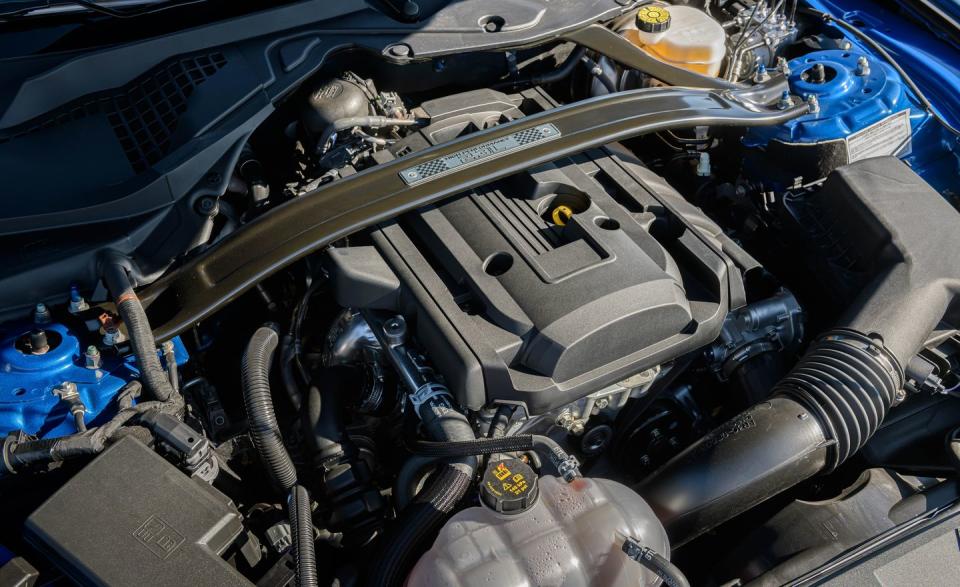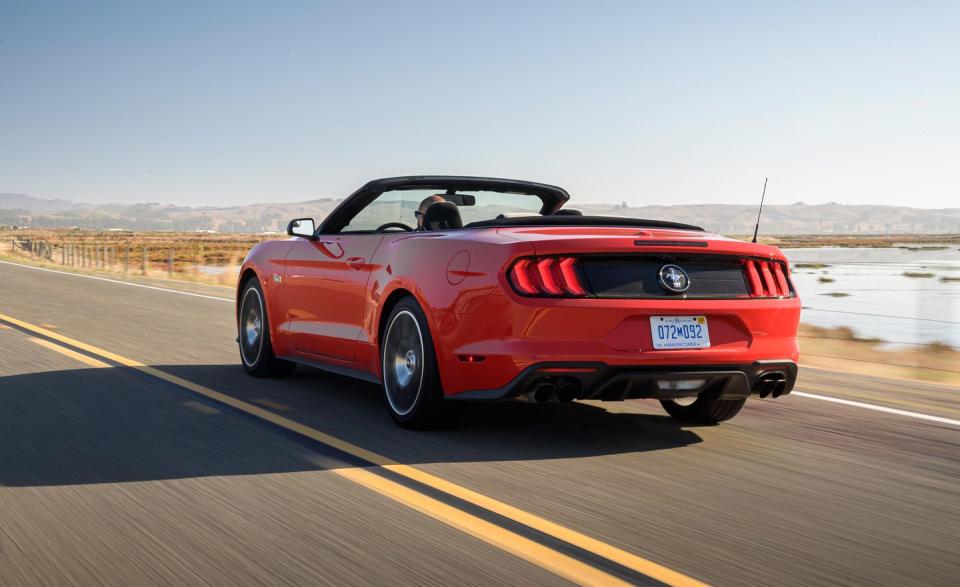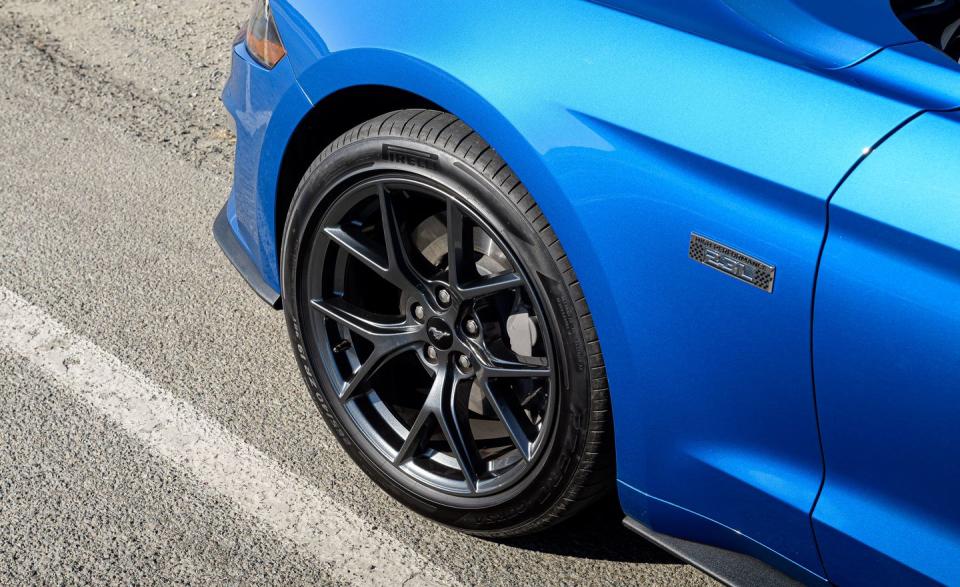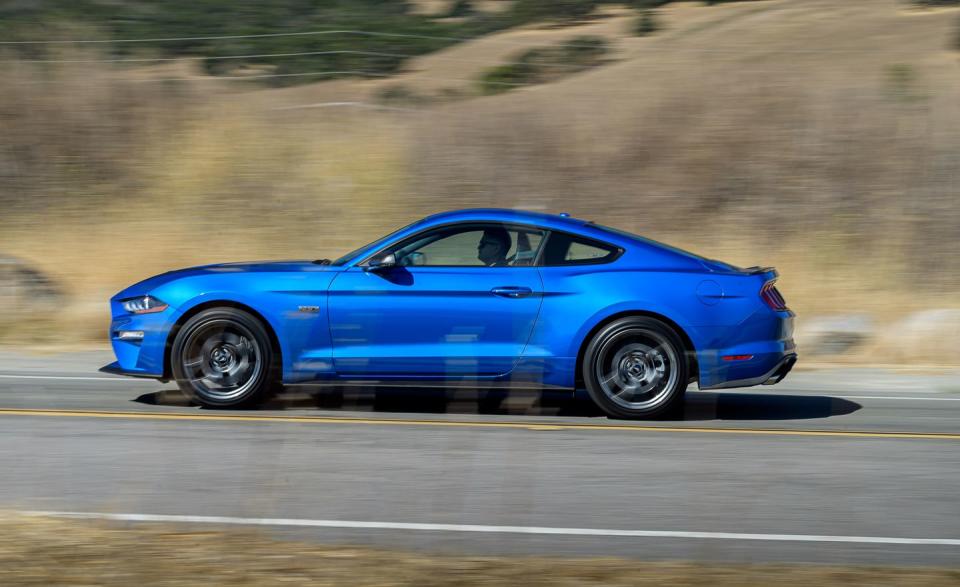2020 Ford Mustang EcoBoost Becomes a Legitimate Performance Car

As Ford prepares to launch its thermonuclear attack in the pony-car wars with the forthcoming 760-hp Shelby GT500, the company also has rearmed and retrained the lowest ranks of the 2020 Mustang corps. Enter the upgraded four-cylinder EcoBoost model, which now offers a feistier turbocharged 2.3-liter inline-four exhumed from the defunct Ford Focus RS, along with transformative racetrack hardware.
Conventionalists have stigmatized six- and four-cylinder muscle cars since the days of old, when there was nothing muscular about either engine type. Things are different today. The current Mustang EcoBoost's standard turbo four-banger makes 310 horsepower and 350 lb-ft of torque. For comparison, the fourth-gen Mustang GT, with its 4.6-liter V-8, maxed out at 260 ponies and 302 lb-ft. Still, the EcoBoost's huge power advantage has been diminished by its bashful exhaust note and less energetic behavior—at least until now.

Ghost of Focus RS Past
The newly available High Performance package swaps the base EcoBoost spec engine for a detuned version of the 2.3-liter unit that powered the all-wheel-drive Focus RS. Ford accomplished this by recalibrating it to work with the standard six-speed manual and optional 10-speed automatic transmissions, as well as making it work long-ways in the rear-drive Stang. Also added were a larger twin-scroll turbo compressor, a bigger radiator, and an active exhaust system. Output is now 332 horses—18 less than the RS made—and the same 350 lb-ft as before. Ford says the RS-derived EcoBoost mill brings broader horsepower and torque curves; the engine is most responsive between 2500 and 5300 rpm.
We were immediately smitten by the EcoBoost's newfound voice on our drive along California's snaking coastline. The updated engine's aural character and throttle response are notably better than the Mustang's base turbo four, growling like a baby lion at startup and snorting through the rev range. While there's a brief hesitation in throttle response just off idle, the 2.3-liter is entertaining and encourages you to chase its 6500-rpm redline. Even the optional automatic gearbox's ability to smoothly shuffle its 10 ratios impresses, both in the default D position and the sportier S setting. The latter mode proved better for maximizing thrust out of tight and twisty corners; simply tickle the throttle and the automatic will snap into the optimal gear and hold it to redline. Of course, we have a sweet spot for the Mustang's standard manual transmission, and the six-speed's notchy shifter and progressive clutch action don't disappoint either. Unlike V-8 models, though, four-cylinder Mustangs do not feature automatic rev matching for those who can't heel-and-toe shift.

The High Performance package inherits equipment from the more powerful Mustang GT and its available Performance package, including larger 13.9-inch front brake rotors with four-piston calipers and a thicker rear anti-roll bar. A strut-tower brace; sticky 19-inch summer tires, sized 255/40R-19; and a 3.55:1 limited-slip differential are also part of the package. And Ford Performance retuned the electrically assisted steering rack, anti-lock braking, stability control, and selectable drive modes. The upgrade brings a higher, 155-mph speed governor as well.
Carving Corners
Although the High Performance package is available on both coupe and convertible models, the EcoBoost Handling package is reserved for the fixed-roof model. Think of it as the four-cylinder's equivalent of the V-8's optional Performance Pack Level 2. The Handling pack is more forgiving on a daily basis than the PPL2, yet similarly rewarding. It significantly improves driver engagement, thanks to adaptive dampers, hardier brake pads, and an even stiffer rear anti-roll bar. Stickier 265/40R-19 Pirelli P Zero Corsa4 tires on wider 19-inch wheels also contribute to additional cornering grip and steering fidelity.

The difference is noticeable. With the Handling package, the car turns into corners more directly and offers better feedback on-center, and there's none of the road-following tramlining that's omnipresent on the Mustang's GT PPL2 and Shelby GT350 variants. Combined with the grippier tires, the updates transform the Mustang EcoBoost into a road scalpel that almost never understeers around corners and maintains a remarkably civil ride quality over undulating tarmac. As with other contemporary Mustangs, try out the optional and almost too heavily bolstered Recaro sport seats before you buy.
Making Cents
Given the performance developments Ford has applied to the latest V-8 Mustangs and the availability of 1LE track-focused hardware on both four- and six-cylinder versions of its crosstown rival, the Chevy Camaro, the introduction of the High Performance package is not surprising. Ford's updates work, and they help to close the gap at the lower end of these two longtime competitors' lineups.

The High Performance package costs $4995, which makes for an entry point of $32,760 for a manual-equipped coupe. The convertible equivalent costs $38,260, and the optional 10-speed automatic adds $1595 to either body style. The EcoBoost's coupe-only Handling package is a reasonable $1995 by itself, but it's handcuffed to both the High Performance pack and the $2000 Equipment Group 101A, inflating the starting price for a full-zoot EcoBoost Mustang to $36,755. Although the bundle brings more standard features than a Camaro 1LE, it means the Ford with both of its performance packages is about $3200 more expensive than a Camaro V-6 1LE and nearly $5800 pricier than the 1LE Chevy with its base 2.0-liter turbo four.
Still, brand loyalty runs deeper than sticker prices, and now the entry-level Mustang can finally go head-to-head with its core competitor. Armed with a proper performance engine and fitted with track-ready equipment, the 2020 Mustang EcoBoost is a legitimate weapon in Ford's expanding pony-car arsenal.
You Might Also Like

